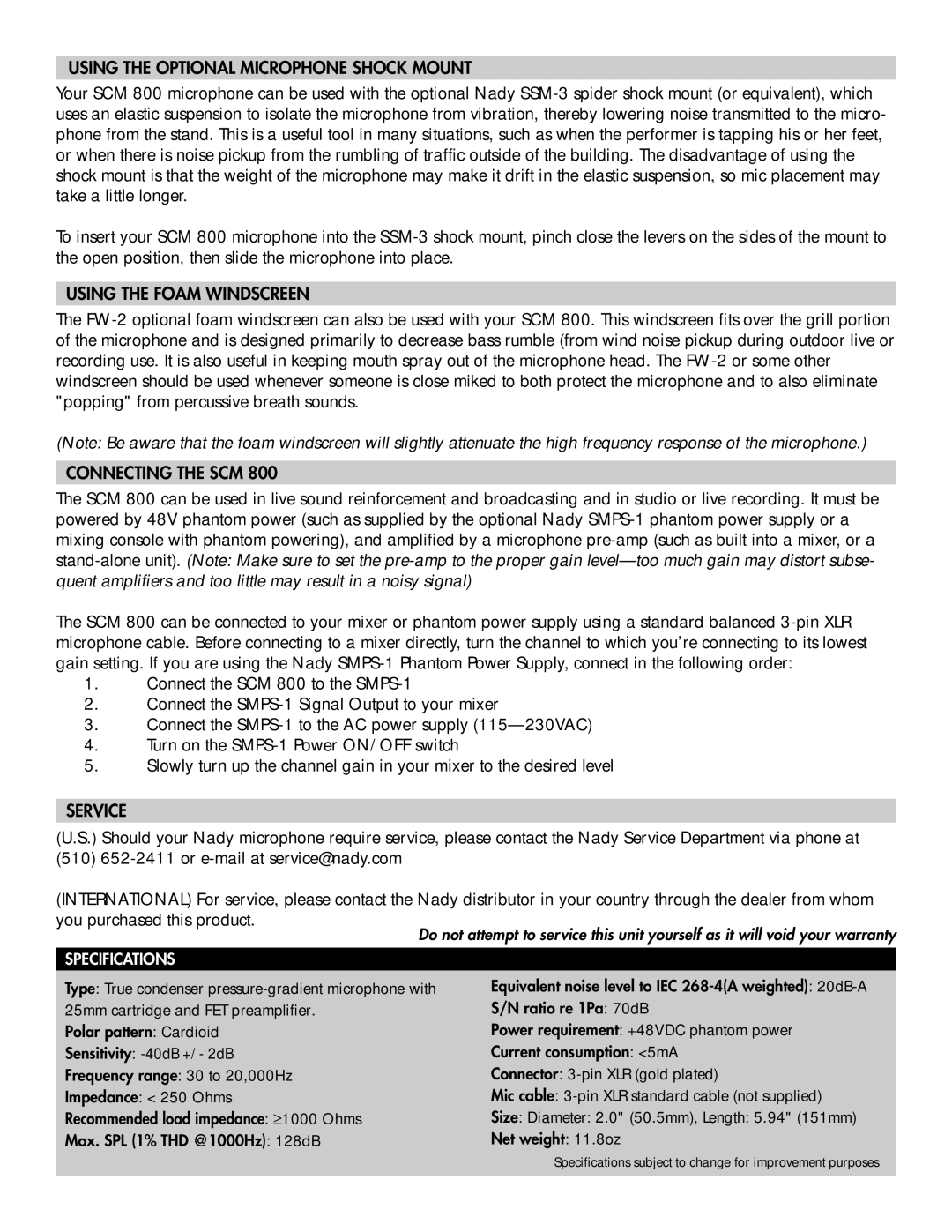USING THE OPTIONAL MICROPHONE SHOCK MOUNT
Your SCM 800 microphone can be used with the optional Nady SSM-3 spider shock mount (or equivalent), which uses an elastic suspension to isolate the microphone from vibration, thereby lowering noise transmitted to the micro- phone from the stand. This is a useful tool in many situations, such as when the performer is tapping his or her feet, or when there is noise pickup from the rumbling of traffic outside of the building. The disadvantage of using the shock mount is that the weight of the microphone may make it drift in the elastic suspension, so mic placement may take a little longer.
To insert your SCM 800 microphone into the SSM-3 shock mount, pinch close the levers on the sides of the mount to the open position, then slide the microphone into place.
USING THE FOAM WINDSCREEN
The FW-2 optional foam windscreen can also be used with your SCM 800. This windscreen fits over the grill portion of the microphone and is designed primarily to decrease bass rumble (from wind noise pickup during outdoor live or recording use. It is also useful in keeping mouth spray out of the microphone head. The FW-2 or some other windscreen should be used whenever someone is close miked to both protect the microphone and to also eliminate "popping" from percussive breath sounds.
(Note: Be aware that the foam windscreen will slightly attenuate the high frequency response of the microphone.)
CONNECTING THE SCM 800
The SCM 800 can be used in live sound reinforcement and broadcasting and in studio or live recording. It must be powered by 48V phantom power (such as supplied by the optional Nady SMPS-1 phantom power supply or a mixing console with phantom powering), and amplified by a microphone pre-amp (such as built into a mixer, or a stand-alone unit). (Note: Make sure to set the pre-amp to the proper gain level—too much gain may distort subse- quent amplifiers and too little may result in a noisy signal)
The SCM 800 can be connected to your mixer or phantom power supply using a standard balanced 3-pin XLR microphone cable. Before connecting to a mixer directly, turn the channel to which you’re connecting to its lowest gain setting. If you are using the Nady SMPS-1 Phantom Power Supply, connect in the following order:
1.Connect the SCM 800 to the SMPS-1
2.Connect the SMPS-1 Signal Output to your mixer
3.Connect the SMPS-1 to the AC power supply (115—230VAC)
4.Turn on the SMPS-1 Power ON/OFF switch
5.Slowly turn up the channel gain in your mixer to the desired level
SERVICE
(U.S.) Should your Nady microphone require service, please contact the Nady Service Department via phone at (510) 652-2411 or e-mail at service@nady.com
(INTERNATIONAL) For service, please contact the Nady distributor in your country through the dealer from whom you purchased this product.
Do not attempt to service this unit yourself as it will void your warranty
SPECIFICATIONS | |
Type: True condenser pressure-gradient microphone with | Equivalent noise level to IEC 268-4(A weighted): 20dB-A |
25mm cartridge and FET preamplifier. | S/N ratio re 1Pa: 70dB |
Polar pattern: Cardioid | Power requirement: +48VDC phantom power |
Sensitivity: -40dB +/- 2dB | Current consumption: <5mA |
Frequency range: 30 to 20,000Hz | Connector: 3-pin XLR (gold plated) |
Impedance: < 250 Ohms | Mic cable: 3-pin XLR standard cable (not supplied) |
Recommended load impedance: ≥ 1000 Ohms | Size: Diameter: 2.0" (50.5mm), Length: 5.94" (151mm) |
Max. SPL (1% THD @1000Hz): 128dB | Net weight: 11.8oz |
| Specifications subject to change for improvement purposes |

